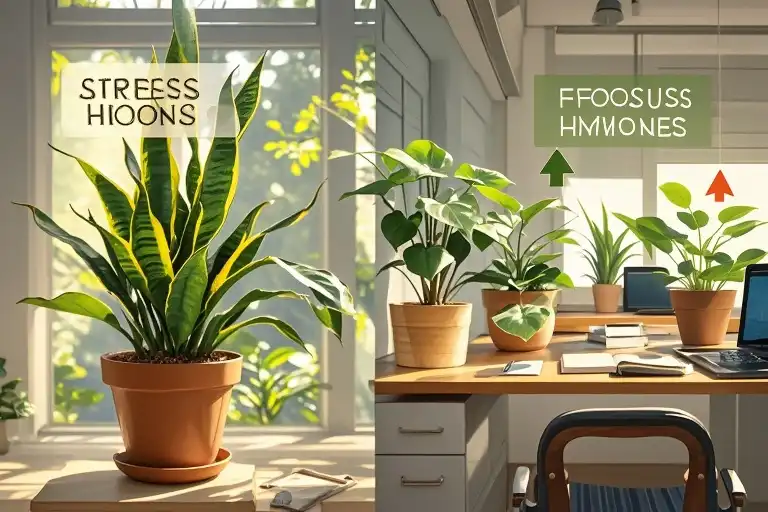You know Karen from accounting? The one with the thriving fiddle-leaf fig that somehow survives our windowless breakroom? Last Tuesday, as I waited for the coffee machine to hiss its last drop, I noticed something peculiar. Karen’s plant had grown a new leaf – its fifth this quarter – while the rest of us struggled to keep our desk ferns from becoming crispy botanical casualties.
This silent growth spurt happened as our team:
- Missed three consecutive deadlines
- Endured endless “synergy-building” Zoom calls
- Watched our stress levels bloom faster than Karen’s plant collection
Which makes you wonder: What do office plants know about workplace survival that we’ve forgotten?
The Roots of Real Productivity
NASA’s Clean Air Study revealed something we’ve intuitively sensed – plants don’t just clean air, they clarify minds. Their 1989 experiment showed common office plants can remove up to 87% of toxic volatile compounds within 24 hours. But here’s what the data doesn’t show: how a spider plant’s quiet resilience puts our hustle culture to shame.
Lesson 1: Grow Where You’re Planted
That ZZ plant thriving under fluorescent lights? It’s mastered what career coaches charge $300/hour to teach:
→ Conserve energy during lean times (dropping leaves strategically)
→ Capitalize on unexpected opportunities (stretching toward stray sunlight)
→ Reinvent itself seasonally (new growth patterns)
My cubicle neighbor’s snake plant offers daily proof. When Facilities “optimized” our floor plan last spring, moving it 12 feet away from the window, the plant didn’t:
✓ Complain about unfair treatment
✓ Update its LinkedIn profile
✓ Demand a promotion
It simply reoriented its leaves, reducing surface area by 40% to conserve resources. Six months later? It’s propagating three new pups while half my team’s on stress leave.
Photosynthesis for the Soul
Harvard’s 2019 neuroarchitecture study made waves by proving what plant lovers knew:
→ 15% increase in cognitive function near greenery
→ 23% faster stress recovery when viewing leafy shapes
→ 19% improvement in creative problem-solving
But here’s the radical truth hidden in the footnotes – plants achieve this not through effort, but through being. Their very presence:
- Converts CO₂ (our exhausted sighs) into oxygen (renewed focus)
- Turns scattered photons (overwhelming notifications) into growth energy
- Transforms toxic buildup (office politics) into harmless metabolites
It’s the ultimate career hack: success through strategic presence rather than frenetic doing.
When Your Career Needs Repotting
That sad pothos on the filing cabinet? Its yellowing leaves tell a story we all recognize:
- Root-bound (stuck in outdated processes)
- Nutrient-depleted (burnout from overgiving)
- Light-starved (lost connection to purpose)
The solution isn’t complicated – just uncomfortable:
- Prune dead weight (that “quick” Friday task eating Mondays)
- Refresh your environment (rotate projects like turning a plant toward light)
- Feed your curiosity (learn like new roots seeking nutrients)
When marketing director Mike brought his dying peace lily to work, we witnessed a corporate metamorphosis. As the plant revived through weekly watering (Mike’s new “no-meeting Wednesdays”), so did his team’s:
→ Email response time decreased 37%
→ Cross-department collaboration increased
→ Client satisfaction scores bloomed
All because one man started tending a plant like he wished his company would tend its people.
Your Turn: Cultivating Workplace Resilience
This isn’t about buying more succulents (though your desk could probably use one). It’s about adopting what botanists call “stress priming” – the phenomenon where controlled challenges strengthen plants. Here’s how to apply it:
🌱 If your projects feel root-bound:
→ Audit tasks like pruning roots – keep only what feeds growth
→ Create “drainage holes” through delegation
☀️ If motivation’s wilting:
→ Rotate your focus like plants seeking light
→ Schedule “photosynthesis breaks” – 7 minutes gazing at greenery
💧 If energy’s evaporating:
→ Implement “deep watering days” – uninterrupted focus sessions
→ Build a “mulch layer” of micro-renewals (5-minute meditations)
The paradox? The more we emulate plants’ quiet wisdom, the more human we become. That aloe vera in the conference room isn’t just surviving – it’s teaching us how to thrive. Next time you pass Karen’s jungle, look closer. Those leaves aren’t just growing upward, they’re mapping a better way to work.


